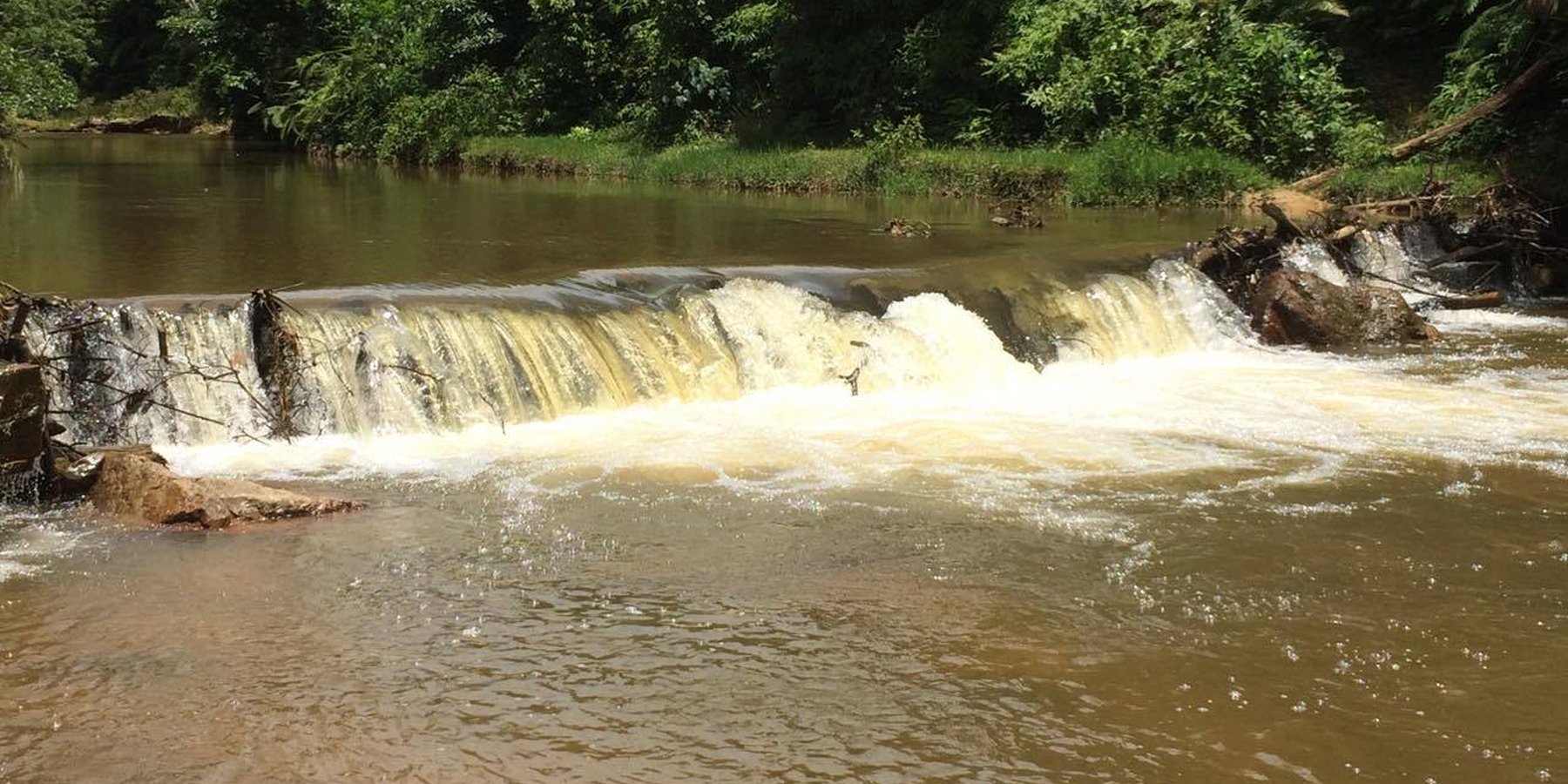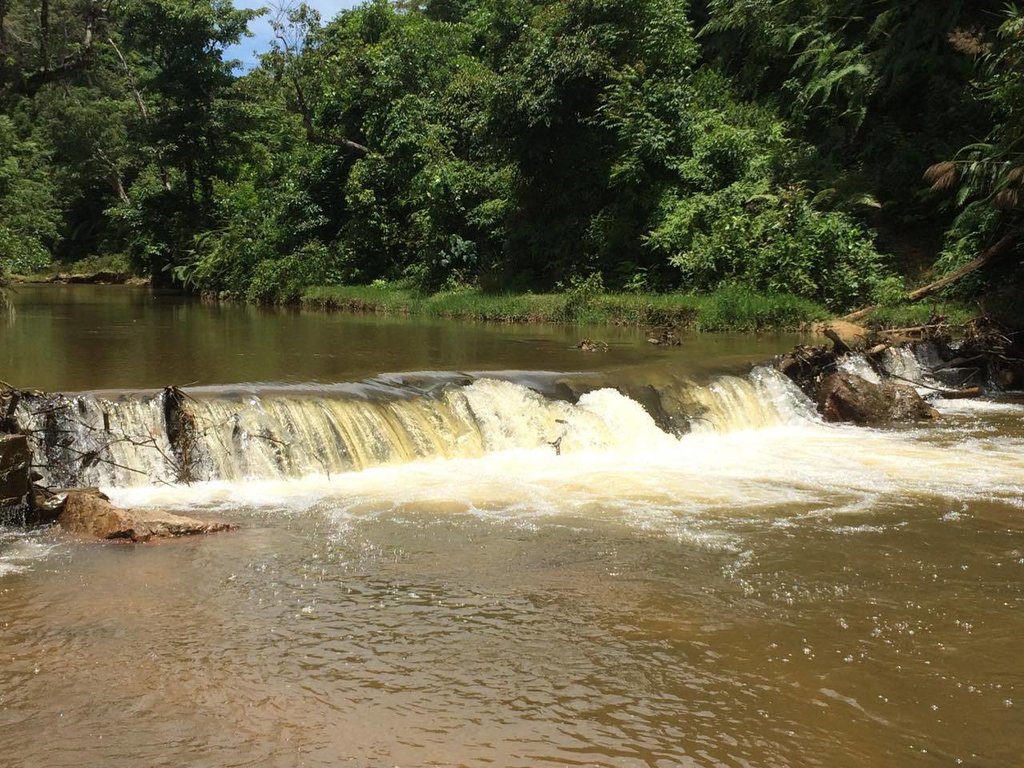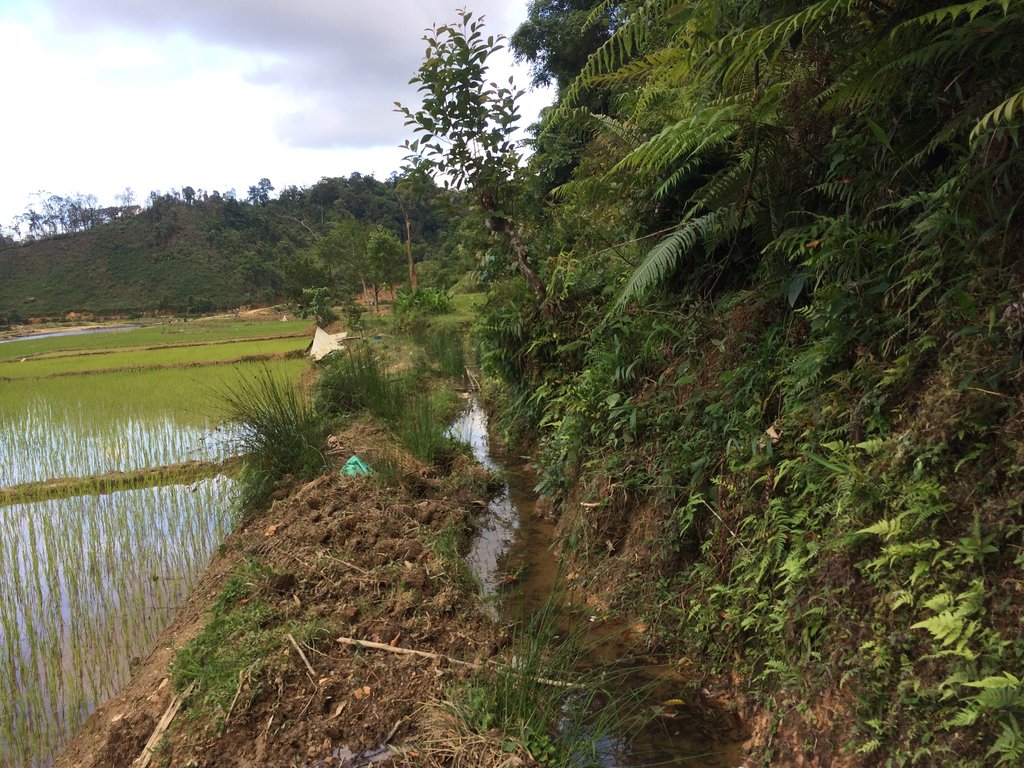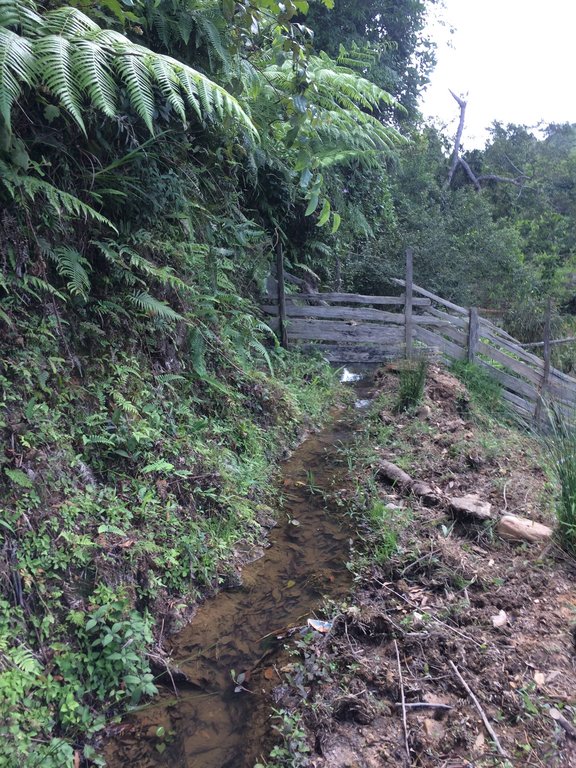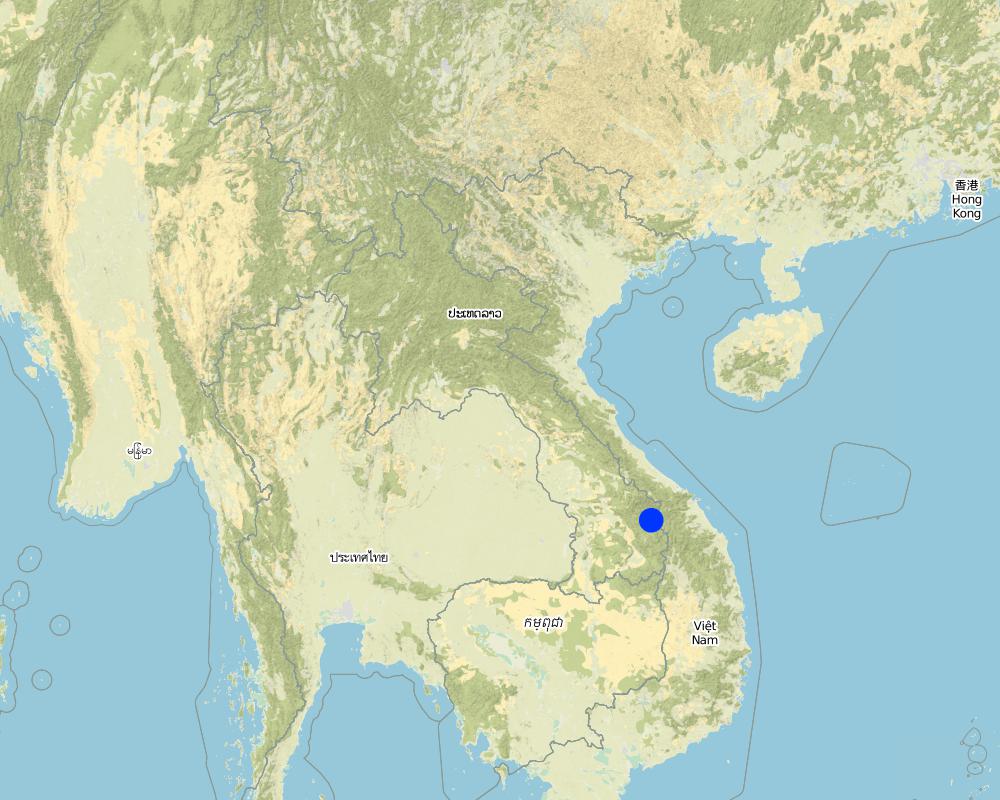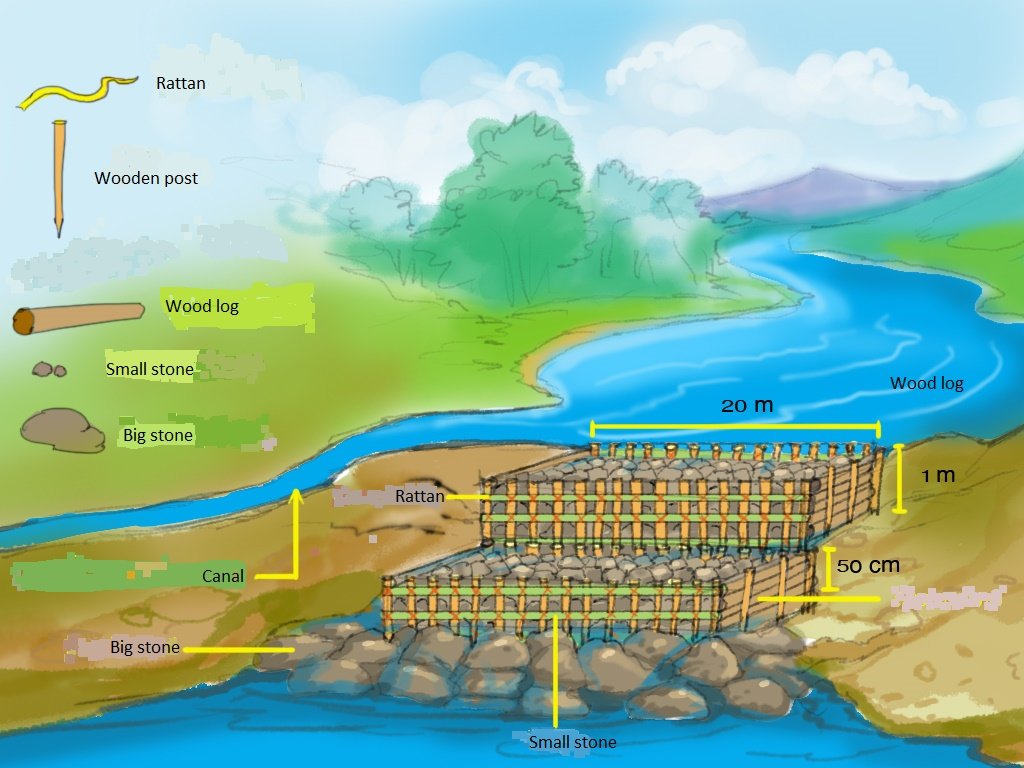Local indigenous dyke for water harvesting [សាធារណរដ្ឋប្រជាធិបតេយ្យប្រជាមានិតឡាវ]
- ការបង្កើត៖
- បច្ចុប្បន្នភាព
- អ្នកចងក្រង៖ kang phanvongsa
- អ្នកកែសម្រួល៖ Pasalath Khounsy, Bounthanom Bouahom, anousit namsena
- អ្នកត្រួតពិនិត្យច្រើនទៀត៖ Nicole Harari, viengsavanh phimphachanhvongsod, Stephanie Jaquet, Alexandra Gavilano
technologies_2306 - សាធារណរដ្ឋប្រជាធិបតេយ្យប្រជាមានិតឡាវ
ពិនិត្យមើលគ្រប់ផ្នែក
ពង្រីកមើលទាំងអស់ បង្រួមទាំងអស់1. ព័ត៌មានទូទៅ
1.2 ព័ត៌មានលម្អិតពីបុគ្គលសំខាន់ៗ និងស្ថាប័នដែលចូលរួមក្នុងការវាយតម្លៃ និងចងក្រងឯកសារនៃបច្ចេកទេស
បុគ្គលសំខាន់ម្នាក់ (ច្រើននាក់)
អ្នកប្រើប្រាស់ដី:
Sengmany
សាធារណរដ្ឋប្រជាធិបតេយ្យប្រជាមានិតឡាវ
អ្នកប្រើប្រាស់ដី:
Sekhamphone Yangmao
សាធារណរដ្ឋប្រជាធិបតេយ្យប្រជាមានិតឡាវ
អ្នកជំនាញឯកទេស SLM:
ឈ្មោះគម្រោងដែលបានចងក្រងឯកសារ/ វាយតម្លៃលើបច្ចេកទេស (បើទាក់ទង)
Scaling-up SLM practices by smallholder farmers (IFAD)ឈ្មោះអង្គភាពមួយ (ច្រើន) ដែលបានចងក្រងឯកសារ/ វាយតម្លៃបច្ចេកទេស (បើទាក់ទង)
National Agriculture and Forestry Research Institute (NAFRI) - សាធារណរដ្ឋប្រជាធិបតេយ្យប្រជាមានិតឡាវ1.3 លក្ខខណ្ឌទាក់ទងទៅនឹងការប្រើប្រាស់ទិន្នន័យដែលបានចងក្រងតាមរយៈ វ៉ូខេត
អ្នកចងក្រង និង(បុគ្គលសំខាន់ៗ)យល់ព្រមទទួលយកនូវលក្ខខណ្ឌនានាទាក់ទងទៅនឹងការប្រើប្រាស់ទិន្នន័យដែលបានចងក្រងតាមរយៈវ៉ូខេត:
បាទ/ចា៎
1.4 សេចក្តីប្រកាសស្តីពីចីរភាពនៃការពណ៌នាពីបច្ចេកទេស
តើបច្ចេកទេសដែលបានពណ៌នានេះមានបញ្ហាដែលផ្តោតលើការធ្លាក់ចុះគុណភាពដី, បើដូច្នេះវាមិនអាចត្រូវបានប្រកាសថាជាបច្ចេកទេសនៃការគ្រប់គ្រងប្រកបដោយចីរភាពទេ?
ទេ
2. ការពណ៌នាពីបច្ចេកទេស SLM
2.1 ការពណ៌នាដោយសង្ខេបពីបច្ចេកទេស
និយមន័យបច្ចេកទេស:
A Local Indigenous Weir to Harness Water
2.2 ការពណ៌នាលម្អិតពីបច្ចេកទេស
ការពណ៌នា:
Local villagers initiated the construction and use of communal weir with locally available materials such as wood and stones to create structure and stabilize the weir. Previously, the local people had constructed several irrigation weirs on a particular stream with each one being adjacent to an individual farm. However this arrangement created water use conflicts, particularly during dry season. Therefore people decided to group together in 2003 in order to build a communal weir and vowed to maintain it on an annual basis. This was a significant commitment as often it is difficult to find the necessary construction materials for the weir’s upkeep.
The main features and components of its framework should be prepared in the following manner: Firstly prior to beginning the weir’s construction one should gather rattan with length of 1-1.5 meters to tie the logs with each posts, as well as post with a diameter approximately 10 cm that should be cut to a length of 1.5 meters. The posts should then be sharpened at the end so that they can ideally be driven 50 cm into the ground, but this will depend on the conditions at the weir site. There should be a distance of 50 cm between each of the posts and these should be installed in two parallel rows with a space of 1 meter between the rows each rows width 1 meters and height 1 meter from the ground that cross the stream about 25 meters long.
Once this has been completed logs with diameter about 20 cm and a length of 4-5 meters should be slotted behind the rows posts and lay the another logs on the previous post until reach to the top of the post as the first layer. The second layer behind the logs should consist of small stones, soil, as well as branches and sticks. This procedure should be completed until the wall of horizontal logs has reached the height 1 meter of the top of the posts. Afterwards large stones should be placed as the top layer of the weir’s crest in order to strengthening the weir from flash flood. After that continue repeating the same process for the second row, driven the posts into the ground for 50 cm in front of the first row with distance of 1 meter and lower than first low for 50 cm, slotted behind the rows posts as the first layer. The second layer behind the logs (in front of the first row) consist small stones, soil, branch and sticks. Finally install large stones on the ground in front of the second row in order to strengthening and prevent leakages at bottom of the weir until reaching the required height. For instance, install the first row, then the second row is installed same as the first row in which the height of the second row is lower than the first row about 50 cm, and install large stones on ground of the third row to prevent leakages at bottom of the weir.
The main purpose of the weir is to provide an adequate water supply for agricultural activities in communal areas. Some households have also installed a dynamo (electric generator) with a production capacity of 1 Kwh. It should be noted that it is important to maintain the weir by regularly replacing the logs and adding more stones as required. One of the benefits of the weir is the ability to carry out agricultural activities in both the rainy and dry seasons. Furthermore water can be used for household gardening and the generation of electricity with the installation of a small dynamo where a channel with fast running water has been created. However, the weir does also have some drawbacks such as the significant numbers of logs that are required to firstly build and then maintain the weir annually. Therefore some land owners or land users may not choose this scheme due to these regular maintenance requirements with the need for logs which are declining in numbers and becoming increasingly difficult to source. At the same time this requirement may also affect forest resources and places time pressure on people to conduct the maintenance.
2.3 រូបភាពនៃបច្ចេកទេស
2.5 ប្រទេស/តំបន់/ទីតាំងកន្លែង ដែលបច្ចេកទេសត្រូវបានអនុវត្ត និងបានគ្រប់ដណ្តប់ដោយការវាយតម្លៃនេះ
ប្រទេស:
សាធារណរដ្ឋប្រជាធិបតេយ្យប្រជាមានិតឡាវ
តំបន់/រដ្ឋ/ខេត្ត:
Tangnong village, Dakchaung district, Sekong province
បញ្ជាក់ពីការសាយភាយនៃបច្ចេកទេស:
- អនុវត្តនៅកន្លែងជាក់លាក់មួយ/ ប្រមូលផ្តុំនៅតំបន់តូចៗ
មតិយោបល់:
There are 2 dykes on that stream
Map
×2.6 កាលបរិច្ឆេទនៃការអនុវត្ត
បង្ហាញឆ្នាំនៃការចុះអនុវត្ត:
2003
ប្រសិនបើមិនច្បាស់ឆ្នាំ សូមបញ្ជាក់កាលបរិច្ឆេទដែលប្រហាក់ប្រហែល:
- 10-50 ឆ្នាំ
2.7 ការណែនាំពីបច្ចេកទេស
សូមបញ្ជាក់តើបច្ចេកទេសត្រូវបានណែនាំឱ្យអនុវត្តដោយរបៀបណា:
- ជាផ្នែកនៃប្រព័ន្ធប្រពៃណី (> 50 ឆ្នាំ)
3. ចំណាត់ថ្នាក់នៃបច្ចេកទេស SLM
3.1 គោលបំណងចម្បង (១ ឬច្រើន) នៃបច្ចេកទេសនេះ
- ធ្វើឱ្យប្រសើរឡើងនូវផលិតកម្ម
- កាត់បន្ថយហានិភ័យនៃគ្រោះមហន្តរាយ
- បន្ស៊ាំទៅនឹងការប្រែប្រួលអាកាសធាតុ/គ្រោះមហន្តរាយ និងផលប៉ះពាល់របស់វា
3.2 ប្រភេទដីប្រើប្រាស់មួយប្រភេទ (ច្រើនប្រភេទ) ដែលបានអនុវត្តបច្ចេកទេស

ដីដាំដំណាំ
- ដំណាំប្រចាំឆ្នាំ
ដំណាំប្រចាំឆ្នាំ - បញ្ជាក់ប្រភេទដំណាំ:
- ធញ្ញជាតិ - ស្រូវ (តំបន់ដីសើម)
- បន្លែ - ផ្សេងៗ
ចំនួនសារដែលដាំដំណាំក្នុងមួយឆ្នាំ:
- 1
សូមបញ្ជាក់:
paddy rice is the main product

ផ្លូវទឹក ផ្ទៃទឹក ដីសើម
- ស្រះ ទំនប់
ផលិតផល/សេវាកម្មចម្បង:
paddy rice, electric generation
3.4 ការផ្គត់ផ្គង់ទឹក
ការផ្គត់ផ្គង់ទឹកនៅកន្លែងអនុវត្តបច្ចេកទេស:
- ប្រព័ន្ធស្រោចស្រពទាំងស្រុង
3.5 ក្រុម SLM ដែលបច្ចេកទេសស្ថិតនៅក្នុង
- ការស្តុកទុកទឹក
- បច្ចេកទេសប្រើប្រាស់ថាមពលមានប្រសិទ្ធភាព
- កាត់បន្ថយហានិភ័យនៃបញ្ហាលើប្រព័ន្ធអេកូឡូស៊ី
3.6 វិធានការ SLM ដែលបញ្ចូលនូវបច្ចេកទេស

វិធានការរចនាស័ម្ពន្ធ
- S5: ទំនប់ ថ្លុក ស្រះ
- S10: វិធានការសន្សំថាមពល
3.7 កំណត់ប្រភេទនៃការធ្លាក់ចុះគុណភាពដីសំខាន់ៗដែលបច្ចេកទេសនេះបានដោះស្រាយ

ការធ្លាក់ចុះសារធាតុគីមីក្នុងដី
- Cn: ការថយចុះជីជាតិ និងកាត់បន្ថយបរិមាណសារធាតុសរីរាង្គ (មិនកើតឡើងដោយការហូរច្រោះទេ)

ការបាត់បង់ទឹក
- Ha: ការថយចុះសំណើមដី
3.8 ការពារ កាត់បន្ថយ ឬស្តារឡើងវិញនៃការធ្លាក់ចុះគុណភាពដី
បញ្ជាក់ពីគោលដៅរបស់បច្ចេកទេស ដែលផ្តោតទៅការធ្លាក់ចុះគុណភាពដី:
- ការកាត់បន្ថយការធ្លាក់ចុះគុណភាពដី
មតិយោបល់:
Sediments are leached from the mountain areas flow down to the stream ant therefrore the water contains organic matter that is beneficial for crops.
4. បច្ចេកទេសជាក់លាក់ សកម្មភាពអនុវត្ត ធាតុចូល និងថ្លៃដើម
4.1 គំនូសបច្ចេកទេសនៃបច្ចេកទេសនេះ
លក្ខណៈពិសេសនៃបច្ចេកទេស (ទាក់ទងនឺងគំនូរបច្ចេកទេស):
The posts have length of about 1.5 m that are fixed into the ground water bottom at a deepness of around 50 cm.
There are two dike rows, each have width of 1 m and a length of approximattly 25 m (corresponding to the width of the stream)
The space between the two dikes is 1 m, the slope angle is 3-5 %
The beneficial area of these dikes is 10 ha of irrigated rice.
The construction material used consists of wooden post (diameters 10 cm and/a length 1.5 m), wood logs with of 20 cm diameter and length of 4-5 m, rattan used to thigten the wood logs with the post. Soil and small stone are put in the back of the wood logs and between the space of the two structures to limit water penetration. Then, also big stones are placed in front of the wood posts to stabilize the structure of the dikes.
After completion of the dike construction, a canal above the upper dike has to be digged to drain the accumulated water into the rice field.
ឈ្មោះអ្នកនិពន្ធ:
Khampheng Bounyavong
កាលបរិច្ឆេទ:
12/05/2017
4.2 ព័ត៌មានទូទៅដែលពាក់ព័ន្ធនឹងការគណនាធាតុចូល និងថ្លៃដើម
កំណត់របៀបនៃការគណនាថ្លៃដើម និងធាតុចូល:
- ក្នុងឯកតាបច្ចេកទេស
បញ្ជាក់ឯកតា:
one dam
បញ្ជាក់ពីទំហំនៃឯកតា (បើពាក់ព័ន្ធ):
width 1m, height 1m, depth 50 cm in the ground, length 25 m cross the steam
ផ្សេងៗ/ រូបិយប័ណ្ណជាតិ (បញ្ជាក់):
Kip
បើពាក់ព័ន្ធសូមកំណត់អត្រាប្តូរប្រាក់ពីដុល្លាទៅរូបិយប័ណ្ណតំបន់ (ឧ. 1 ដុល្លារ = 79.9 រៀលនៃរូបិយប័ណ្ណប្រេស៊ីល) ៖ 1 ដុល្លារ =:
8000,0
កំណត់ថ្លៃឈ្នួលជាមធ្យមនៃការជួលកម្លាំងពលកម្មក្នុងមួយថ្ងៃ:
50 000 kip
4.3 សកម្មភាពបង្កើត
| សកម្មភាព | រយៈពេល (រដូវកាល) | |
|---|---|---|
| 1. | Find dead wood logs | |
| 2. | Collect and prepare the rattan to tighten the wood | |
| 3. | Collect the stones and rocks | |
| 4. | Dyke installation |
4.4 ថ្លៃដើម និងធាតុចូលដែលត្រូវការសម្រាប់ការបង្កើតបច្ចេកទេស
| បញ្ជាក់ពីធាតុចូល | ឯកតា | បរិមាណ | ថ្លៃដើមក្នុងមួយឯកតា | ថ្លៃធាតុចូលសរុប | % នៃថ្លៃដើមដែលចំណាយដោយអ្នកប្រើប្រាស់ដី | |
|---|---|---|---|---|---|---|
| កម្លាំងពលកម្ម | Labour | person | 48,0 | 50000,0 | 2400000,0 | 100,0 |
| សម្ភារៈ | Hummer | piece | 4,0 | 150000,0 | 600000,0 | 100,0 |
| សម្ភារៈ | Axes | piece | 10,0 | 100000,0 | 1000000,0 | 100,0 |
| សម្ភារៈ | Hoe | piece | 15,0 | 40000,0 | 600000,0 | 100,0 |
| សម្ភារៈ | Shovel | piece | 10,0 | 50000,0 | 500000,0 | 100,0 |
| សម្ភារៈ | Knife | piece | 10,0 | 25000,0 | 250000,0 | 100,0 |
| សម្ភារៈសាងសង់ | Wood logs | piece | 10,0 | 50000,0 | 500000,0 | 100,0 |
| សម្ភារៈសាងសង់ | Rattan | line | 200,0 | 20000,0 | 4000000,0 | 100,0 |
| សម្ភារៈសាងសង់ | Stones | m3 | 50,0 | 40000,0 | 2000000,0 | 100,0 |
| សម្ភារៈសាងសង់ | Wood post | piece | 10,0 | 10000,0 | 100000,0 | 100,0 |
| ថ្លៃដើមសរុបក្នុងការបង្កើតបច្ចេកទេស | 11950000,0 | |||||
| ថ្លៃដើមសរុបក្នុងការបង្កើតបច្ចេកទេសគិតជាដុល្លារ | 1493,75 | |||||
4.5 សកម្មភាពថែទាំ
| សកម្មភាព | ពេលវេលា/ ភាពញឹកញាប់ | |
|---|---|---|
| 1. | Find the wood logs to repair the dikes | |
| 2. | Prepare the rattan to refix the logs with the posts | |
| 3. | Collect the stones to imrove the stabilize the dikes | |
| 4. | Repair the dike |
មតិយោបល់:
Each year, people from the local community have to maintain and repair the dikes.
4.6 កំណត់ថ្លៃដើមសម្រាប់ការថែទាំ/ សកម្មភាពរបស់បច្ចេកទេស (ក្នុងរយៈពេលមួយឆ្នាំ)
| បញ្ជាក់ពីធាតុចូល | ឯកតា | បរិមាណ | ថ្លៃដើមក្នុងមួយឯកតា | ថ្លៃធាតុចូលសរុប | % នៃថ្លៃដើមដែលចំណាយដោយអ្នកប្រើប្រាស់ដី | |
|---|---|---|---|---|---|---|
| កម្លាំងពលកម្ម | Labor | person | 48,0 | 50000,0 | 2400000,0 | 100,0 |
| សម្ភារៈសាងសង់ | Wood logs | piece | 10,0 | 50000,0 | 500000,0 | 100,0 |
| សម្ភារៈសាងសង់ | Rattan | line | 200,0 | 10000,0 | 2000000,0 | 100,0 |
| សម្ភារៈសាងសង់ | Stones | m3 | 10,0 | 50000,0 | 500000,0 | 100,0 |
| សម្ភារៈសាងសង់ | Wood post | piece | 10,0 | 10000,0 | 100000,0 | 100,0 |
| ថ្លៃដើមសរុបសម្រាប់ការថែទាំដំណាំតាមបច្ចេកទេស | 5500000,0 | |||||
| ថ្លៃដើមសរុបសម្រាប់ការថែទាំដំណាំតាមបច្ចេកទេសគិតជាដុល្លារ | 687,5 | |||||
4.7 កត្តាសំខាន់បំផុតដែលមានឥទ្ធិពលដល់ការចំណាយ
ពណ៌នាពីកត្តាប៉ះពាល់ចម្បងៗទៅលើថ្លៃដើម:
The labour for collecting the wood logs and the labour for the construction of the dike.
5. លក្ខណៈបរិស្ថានធម្មជាតិ និងមនុស្ស
5.1 អាកាសធាតុ
បរិមាណទឹកភ្លៀងប្រចាំឆ្នាំ
- < 250 មម
- 251-500 មម
- 501-750 មម
- 751-1,000 មម
- 1,001-1,500 មម
- 1,501-2,000 មម
- 2,001-3,000 មម
- 3,001-4,000 មម
- > 4,000 មម
កំណត់បរិមាណទឹកភ្លៀង (បើដឹង) ជា មីលីម៉ែត្រ:
870,00
លក្ខណៈពិសេស/ មតិយោបល់លើរដូវភ្លៀង:
The driest month is January, with 14 mm of rainfall. In July, the precipitation reaches its peak. Heavy rain is between July-September. Total rain fall is about 3200 mm/year
បញ្ជាក់ឈ្មោះឯកសារយោងនៃស្ថានីយឧតុនិយម:
Natural resource office
តំបន់កសិអាកាសធាតុ
- សើម
The warmest month of the year is May, with an average temperature of 22.3 °C. With16.6 °C on average, January is the coldest month of the year.
5.2 សណ្ឋានដី
ជម្រាលជាមធ្យម:
- រាបស្មើ (0-2%)
- ជម្រាលតិចតួច (3-5%)
- មធ្យម (6-10%)
- ជម្រាលខ្ពស់បន្តិច (11-15%)
- ទីទួល (16-30%)
- ទីទួលចោត (31-60%)
- ទីទួលចោតខ្លាំង (>60%)
ទម្រង់ដី:
- ខ្ពង់រាប
- កំពូលភ្នំ
- ជម្រាលភ្នំ
- ជម្រាលទួល
- ជម្រាលជើងភ្នំ
- បាតជ្រលងភ្នំ
តំបន់តាមរយៈកម្ពស់ :
- 0-100 ម
- 101-500 ម
- 501-1,000 ម
- 1,001-1,500 ម
- 1,501-2,000 ម
- 2,001-2,500 ម
- 2,501-3,000 ម
- 3,001-4,000 ម
- > 4,000 ម
បញ្ជាក់ថាតើបច្ចេកទេសនេះត្រូវបានអនុវត្តន៍នៅក្នុង:
- សណ្ឋានដីប៉ោង
5.3 ដី
ជម្រៅដីជាមធ្យម:
- រាក់ខ្លាំង (0-20 សម)
- រាក់ (21-50 សម)
- មធ្យម (51-80 សម)
- ជ្រៅ (81-120 សម)
- ជ្រៅខ្លាំង (> 120 សម)
វាយនភាពដី (ស្រទាប់លើ):
- គ្រើម/ មានពន្លឺ (ខ្សាច់)
វាយនភាពដី (> 20 សម ស្រទាប់ក្នុង):
- មធ្យម (ល្បាយ, ល្បាប់)
សារធាតុសរីរាង្គនៅស្រទាប់ដីខាងលើ:
- មធ្យម (1-3%)
5.4 ទឹកដែលអាចទាញមកប្រើប្រាស់បាន និងគុណភាពទឹក
នីវ៉ូទឹកក្រោមដី:
< 5 ម
ទឹកលើដីដែលអាចទាញយកប្រើប្រាស់បាន:
កម្រិតមធ្យម
គុណភាពទឹក (មិនបានធ្វើប្រត្តិកម្ម):
ទឹកសម្រាប់តែការធ្វើកសិកម្ម (ស្រោចស្រព)
តើមានបញ្ហាភាពទឹកប្រៃហូរចូលមកដែរឬទេ?
ទេ
តើទឹកជំនន់កំពុងកើតមាននៅតំបន់នេះដែររឺទេ?
ទេ
5.5 ជីវៈចម្រុះ
ភាពសម្បូរបែបនៃប្រភេទ:
- កម្រិតមធ្យម
ភាពសម្បូរបែបនៃទីជម្រក:
- កម្រិតមធ្យម
5.6 លក្ខណៈនៃអ្នកប្រើប្រាស់ដីដែលអនុវត្តបច្ចេកទេស
នៅមួយកន្លែង ឬពនេចរ :
- នៅមួយកន្លែង
ទីផ្សារនៃប្រព័ន្ធផលិតកម្ម:
- សម្រាប់ហូបក្នុងគ្រួសារ (ផ្គត់ផ្គង់ខ្លួនឯង)
ចំណូលក្រៅកសិកម្ម:
- តិចជាង 10% នៃចំណូល
កម្រិតជីវភាព:
- មធ្យម
ឯកជន ឬក្រុម:
- ជាក្រុម/ សហគមន៍
កម្រិតប្រើប្រាស់គ្រឿងយន្ត:
- គ្រឿងយន្ត/ ម៉ាស៊ីន
យេនឌ័រ:
- ស្ត្រី
- បុរស
អាយុរបស់អ្នកប្រើប្រាស់ដី:
- យុវវ័យ
- វ័យកណ្តាល
5.7 ទំហំផ្ទៃដីជាមធ្យមនៃដីប្រើប្រាស់ដោយអ្នកប្រើប្រាស់ដី ក្នុងការអនុវត្តបច្ចេកទេស
- < 0.5 ហិកតា
- 0.5-1 ហិកតា
- 1-2 ហិកតា
- 2-5 ហិកតា
- 5-15 ហិកតា
- 15-50 ហិកតា
- 50-100 ហិកតា
- 100-500 ហិកតា
- 500-1,000 ហិកតា
- 1,000-10,000 ហិកតា
- > 10,000 ហិកតា
តើផ្ទៃដីនេះចាត់ទុកជាទំហំកម្រិតណាដែរ ខ្នាតតូច មធ្យម ឬខ្នាតធំ (ធៀបនឹងបរិបទតំបន់)?
- ខ្នាតតូច
5.8 ភាពជាម្ចាស់ដី កម្មសិទ្ធប្រើប្រាស់ដី និងកម្មសិទ្ធប្រើប្រាស់ទឹក
ភាពជាម្ចាស់ដី:
- ភូមិ
- ឯកជន មិនមានកម្មសិទ្ធ
កម្មសិទ្ធិប្រើប្រាស់ដី:
- ឯកជន
កម្មសិទ្ធប្រើប្រាស់ទឹក:
- អាស្រ័យផលសេរី (មិនមានការកំណត់)
5.9 ការប្រើប្រាស់សេវាកម្ម និងហេដ្ឋារចនាសម្ព័ន្ធ
សុខភាព:
- មិនល្អ
- មធ្យម
- ល្អ
ការអប់រំ:
- មិនល្អ
- មធ្យម
- ល្អ
ជំនួយបច្ចេកទេស:
- មិនល្អ
- មធ្យម
- ល្អ
ការងារ (ឧ. ការងារក្រៅកសិដ្ឋាន):
- មិនល្អ
- មធ្យម
- ល្អ
ទីផ្សារ:
- មិនល្អ
- មធ្យម
- ល្អ
ថាមពល:
- មិនល្អ
- មធ្យម
- ល្អ
ផ្លូវ និងការដឹកជញ្ជូន:
- មិនល្អ
- មធ្យម
- ល្អ
ទឹកផឹក និងអនាម័យ:
- មិនល្អ
- មធ្យម
- ល្អ
សេវាកម្មហិរញ្ញវត្ថុ:
- មិនល្អ
- មធ្យម
- ល្អ
6. ផលប៉ះពាល់ និងការសន្និដ្ឋាន
6.1 ផលប៉ះពាល់ក្នុងបរិវេណអនុវត្តបច្ចេកទេសដែលកើតមាន
ផលប៉ះពាល់លើសេដ្ឋកិច្ចសង្គម
ផលិតផល
គុណភាពដំណាំ
គុណភាពមុន SLM:
8 tons/ha
គុណភាពក្រោយ SLM:
2 tons/ha
មតិយោបល់/ ការបញ្ជាក់:
Before gold mining company entered in the area the yield of rice raised to 8 tons/ha due to the aboundant irrigation water caused by the dike construction. But unfortunately actually (in 2017), due to gold excavating rice yield decreased to 2 tons/ha, only.
ការបង្កើតថាមពល
មតិយោបល់/ ការបញ្ជាក់:
Some households also install dynamo ( electric generator ) with production capacity of 1 Kwh.
ទឹកដែលអាចទាញមកប្រើប្រាស់បាន និងគុណភាពទឹក
ទឹកប្រើប្រាស់សម្រាប់ស្រោចស្រព
មតិយោបល់/ ការបញ្ជាក់:
Before, water for cultivation was insufficient especially during dry season as the stream water level was too low , after the weir construction the stream water level got high enough to fill the canal leading to the production area all-year round.
ផលប៉ះពាល់ទៅលើវប្បធម៌សង្គម
ការកាត់បន្ថយជម្លោះ
មតិយោបល់/ ការបញ្ជាក់:
Before dyke construction the villagers tried to bring water to their fields by small individual canals during dry season. This caused competition and conflicts on scares water scarcity. After the communal wire construction the conflicts situation have been been improved.
ផលប៉ះពាល់ទៅលើអេកូឡូស៊ី
វដ្តទឹក/លំហូរ
បរិមាណទឹក
មតិយោបល់/ ការបញ្ជាក់:
Without dikes, the stream water quantity was too low to produce enough yield mainly regardomg dry season cultivation. After weir construction the farmers let the water flow from the canal into the water reservoir which allows agricultural activities on a year-round basis.
ការកាត់បន្ថយហានិភ័យនៃគ្រោះមហន្តរាយ និងគ្រោះអាកាសធាតុ
ផលប៉ះពាល់នៃគ្រោះរាំងស្ងួត
មតិយោបល់/ ការបញ្ជាក់:
Even during dry season (and drought events) the farmers bring enough the water to the fields.
6.2 ផលប៉ះពាល់ក្រៅបរិវេណអនុវត្តបច្ចេកទេសដែលកើតមាន
លំហូរទឹកដែលអាចប្រើប្រាស់បាននៅរដូវប្រាំង
មតិយោបល់/ ការបញ្ជាក់:
The weir stopped to some extent the natural water flow. This causes slower but still regular downstream water flow during dry season.
6.3 ភាពប្រឈម និងភាពរួសនៃបច្ចេកទេសទៅនឹងការប្រែប្រួលអាកាសធាតុ និងគ្រោះអាកាសធាតុ/ គ្រោះមហន្តរាយ (ដែលដឹងដោយអ្នកប្រើប្រាស់ដី)
ការប្រែប្រួលអាកាសធាតុ
ការប្រែប្រួលអាកាសធាតុ
| រដូវកាល | កើនឡើង ឬថយចុះ | លក្ខណៈឆ្លើយតបនៃបច្ចេកទេសទៅនឹងការប្រែប្រួលអាកាសធាតុ | |
|---|---|---|---|
| សីតុណ្ហភាពប្រចាំឆ្នាំ | កើនឡើង | មធ្យម | |
| សីតុណ្ហភាពប្រចាំរដូវកាល | រដូវប្រាំង | ថយចុះ | ល្អ |
| បរិមាណទឹកភ្លៀងប្រចាំរដូវកាល | សើម/រដូវភ្លៀង | កើនឡើង | មធ្យម |
| ការប្រែប្រួលអាកាសធាតុផ្សេងៗ | None | កើនឡើង | ល្អ |
គ្រោះអាកាសធាតុ (មហន្តរាយ)
គ្រោះមហន្តរាយធម្មជាតិ
| លក្ខណៈឆ្លើយតបនៃបច្ចេកទេសទៅនឹងការប្រែប្រួលអាកាសធាតុ | |
|---|---|
| ព្យុះទឹកកកតាមតំបន់ | មិនល្អ |
គ្រោះមហន្តរាយអាកាសធាតុ
| លក្ខណៈឆ្លើយតបនៃបច្ចេកទេសទៅនឹងការប្រែប្រួលអាកាសធាតុ | |
|---|---|
| ស្ថានភាពខ្យល់ខ្លាំង | មិនល្អ |
គ្រោះមហន្តរាយទឹក
| លក្ខណៈឆ្លើយតបនៃបច្ចេកទេសទៅនឹងការប្រែប្រួលអាកាសធាតុ | |
|---|---|
| ទឹកជំនន់ដោយទឹកភ្លៀង | មធ្យម |
គ្រោះមហន្តរាយជីវៈសាស្ត្រ
| លក្ខណៈឆ្លើយតបនៃបច្ចេកទេសទៅនឹងការប្រែប្រួលអាកាសធាតុ | |
|---|---|
| ការរាតត្បាតនៃជំងឺ | មធ្យម |
| ការមានបញ្ហាសត្វល្អិត/ដង្កូវ | មិនល្អ |
ផលវិបាកដែលទាក់ទងនឹងបរិយាកាសផ្សេងៗទៀត
ផលវិបាកដែលទាក់ទងនឹងបរិយាកាសផ្សេងៗទៀត
| លក្ខណៈឆ្លើយតបនៃបច្ចេកទេសទៅនឹងការប្រែប្រួលអាកាសធាតុ | |
|---|---|
| អូសបន្លាយពេលដាំដុះ | មិនល្អ |
6.4 ការវិភាគថ្លៃដើម និងអត្ថប្រយោជន៍
តើផលចំណេញ និងថ្លៃដើមត្រូវបានប្រៀបធៀបគ្នាយ៉ាងដូចម្តេច (ទស្សនៈរបស់អ្នកប្រើប្រាស់ដី)?
រយៈពេលខ្លី:
វិជ្ជមានតិចតួច
រយៈពេលវែង:
វិជ្ជមានតិចតួច
តើផលចំណេញ និងការថែទាំ/ ជួសជុលត្រូវបានប្រៀបធៀបគ្នាយ៉ាងដូចម្តេច (ទស្សនៈរបស់អ្នកប្រើប្រាស់ដី)?
រយៈពេលខ្លី:
វិជ្ជមានតិចតួច
រយៈពេលវែង:
អវិជ្ជមានតិចតួច
6.5 ការទទួលយកបច្ចេកទេស
- 11-50%
ក្នុងចំណោមគ្រួសារទាំងអស់ដែលបានអនុវត្តបច្ចេកទេស តើមានប៉ុន្មានគ្រួសារដែលចង់ធ្វើដោយខ្លួនឯង ដោយមិនទទួលបានសម្ភារៈលើកទឹកចិត្ត/ប្រាក់ឧបត្ថម្ភ?:
- 91-100%
6.6 ការបន្សុំា
តើថ្មីៗនេះ បច្ចេកទេសនេះត្រូវបានកែតម្រូវដើម្បីបន្ស៊ាំទៅនឹងស្ថានភាពប្រែប្រួលដែរឬទេ?
ទេ
6.7 ភាពខ្លាំង/ គុណសម្បត្តិ/ ឱកាសនៃបច្ចេកទេស
| ភាពខ្លាំង/ គុណសម្បត្តិ/ ឱកាសនៅកន្លែងរបស់អ្នកប្រើប្រាស់ដី |
|---|
| Inputs are economically beneficial. |
| Provides a reliable water supply for agricultural activities. |
| Electricity can be generated with a small dynamo. |
| ភាពខ្លាំង/ គុណសម្បត្តិ/ ឱកាស ទស្សនៈរបស់បុគ្គលសំខាន់ៗ |
|---|
| Mitigates water use conflicts which could occur in the village. |
6.8 ភាពខ្សោយ/ គុណវិបត្តិ/ ហានិភ័យនៃបច្ចេកទេស និងវិធីសាស្ត្រដោះស្រាយ
| ភាពខ្សោយ/ គុណវិបត្តិ/ ហានិភ័យ ទស្សនៈរបស់អ្នកប្រើប្រាស់ដី | តើបច្ចេកទេសទាំងនោះបានដោះស្រាយបញ្ហាដូចម្តេច? |
|---|---|
| It is only possible to construct a temporary weir due to the low quality of locally available materials | |
| A great deal of time needs to be invested in annual maintenance work. |
7. ឯកសារយោង និងវេបសាយ
7.1 វិធីសាស្ត្រ/ ប្រភពនៃព័ត៌មាន
- តាមការចុះទីវាល ការស្រាវជ្រាវនៅទីវាល
1 time
- ការសម្ភាសន៍ជាមួយអ្នកប្រើប្រាស់ដី
2 persons
តើពេលណាដែលទិន្នន័យបានចងក្រង (នៅទីវាល)?
11/05/2017
ការតភ្ជាប់ និងម៉ូឌុល
ពង្រីកមើលទាំងអស់ បង្រួមទាំងអស់ការតភ្ជាប់
គ្មានការតភ្ជាប់
ម៉ូឌុល
គ្មានម៉ូឌុល


